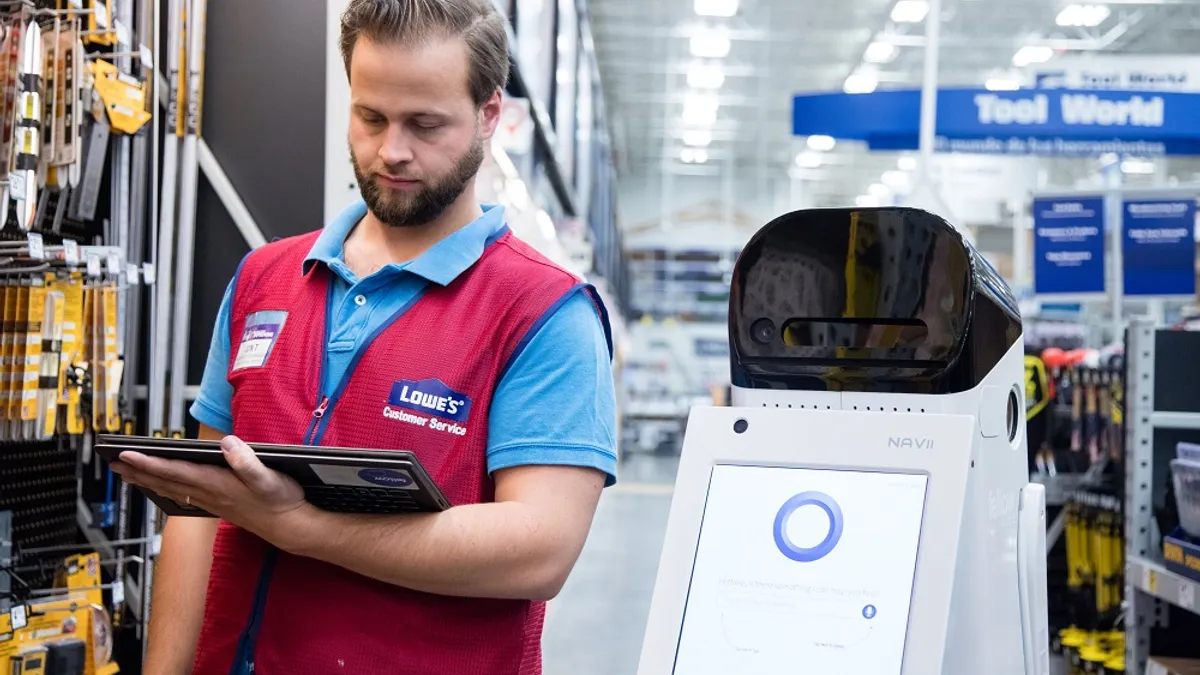The retail industry prides itself on its heritage.
Department stores like Sears and Macy’s were founded just before the turn of the 20th century and have both weathered the tests of time, despite challenges brought on by economic downturns and transformative technologies such as the landline, the internet and, most recently, the smartphone.
But retail today isn't what it used to be. Innovation is now moving much faster than when Sears first invented the catalog or when Macy’s led the way in nationwide big-box store expansion.
As these once-mighty chains and others fall into potential death spirals of mounting challenges, many say it’s time for traditional brick-and-mortar retailers to face a hard truth — innovate or die.
“If you are encountering headwinds, one of the ways to counteract that is to look for a new or better way to deliver value to your customers,” Scott Emmons, head of the Innovation Lab at Neiman Marcus, told Retail Dive earlier this year at an innovation conference.
Many retailers today are scrambling to keep pace with emerging technologies and changing consumer behaviors. Everyone is trying to create stores of the future — whatever those may be. All that has spurred an increasing number of retailers to develop in-house innovation labs — creative teams and spaces that have free range to experiment and find out which in-store and digital technologies work or won't work for a particular retailer.
Home improvement retailer Lowe’s created its Lowe’s Innovation Labs in 2015 as a place for technology and creative teams to test new technologies before rolling them out to the stores. Several years later, the retailer seems to be at the forefront of innovation in the industry: Lowe's now boasts an augmented reality app that helps consumers navigate stores, a virtual reality headset that provides help on DIY projects and a robot with voice recognition that provides assistance in stores.
As retailers grapple with the existential question of what exactly innovation means for them, the discussion forum RetailWire asked its BrainTrust panel of retail experts the following questions:
-
Should major brick-and-mortar retailers invest heavily in innovation labs as a way to experiment with new ideas, get creative and find ways to rejuvenate the physical shopping experience?
-
Which of Lowe’s innovations seems to have the most promise?
Here are nine of the most provocative and insightful comments from that discussion. Comments have been edited by Retail Dive for length and clarity.
1. Innovate or perish
Kai Clarke, CEO, American Retail Consultants: Innovate or perish. That has been the key to success at retail since before Sam Walton. That shouldn’t stop for very aggressive, competitive retailers like Lowe’s or HD. Pushing the envelope really helps both the retailer and the category. “Why stop now?” might be a better question.
2. An expensive indulgence
Bob Phibbs, President/CEO, The Retail Doctor: What I don’t get is how online retailers are obsessed with every interaction point, but physical stores aren’t. I mean, how many retailers pay any attention to anyone coming into their physical store? Personalization is being human. It is great to have innovation labs if they have the goal to be more human. If they are merely a place to play with shiny objects — and not convert more shoppers to customers — they’re an expensive indulgence.
3. Outsource innovation
Dave Nixon, Digital Solutions Executive, Fusion Alliance: Retailers should leverage innovation for their businesses, but only with clearly-defined business cases and use cases for the investment. They should be cautious in building their own. There are plenty of great resources to partner, enter into a joint venture for or rent for this purpose! Innovation WILL rejuvenate the retail experience and needs to be a high priority discussion for every retailer.
4. Focus on humans
Tom Redd, Global Vice President, Strategic Communications, SAP Global Retail Business Unit: Lowe’s should invest in people training and people selling — helping a shopper make a decision. Lowe’s has a few pros who know their processes in home repair and service. That is priority number one — not a Palo Alto robot that can display a YouTube video on doing tile. Anyone can do that. Get a real human to go through the tile process with the rookies.
5. Bring on the robots
Adrian Weidmann, Principal, StoreStream Metrics, LLC: Yesterday I went into a Lowe’s and asked an employee where I could find electric baseboard heating. He quickly opened an app/website on his mobile phone and found what I was looking for but no location in the store. He was confused, asked one of his associates who did exactly the same thing — nothing! They both guided me to “heating stuff” at the other end of the store. I found nothing and asked another employee who quickly informed me that that the item was no longer stocked at the store but was an online purchase only! Another dagger into the relevance of brick-and-mortar retail as we know it! Why go to the store if that’s the experience?
If that’s your benchmark — bring on the robot!
6. Beyond the store
Ricardo Belmar, Sr Director, Worldwide Enterprise Product Marketing, InfoVista: Lowe’s is on the right track with their innovative ideas, however, I question if all of these innovations are purely being considered for the store. For example, if they create a great VR/AR experience in their Holoroom or with their VR-based training solution, why not enable these within their mobile app for a home experience? From a brand loyalty perspective that seems like a winning solution to foster loyalty with Lowe’s and move customers away from Home Depot.
7. Innovation isn’t always sexy
Lee Kent, Principal, Your Retail Authority, LLC: We often interpret innovation as meaning sexy technology, and it is important to remember that is not always the case. The important thing for retailers is to understand their customers’ shopping journey and create great experiences that will have them coming back. These experiences may not involve a robot or even any form of technology but they will simplify or enhance the experience.
So yes, innovation is very important to retailers right now especially in improving the store experience and purpose but it doesn’t always have to be about tech.
8. Experimentation is crucial
Scott Magids, CEO, Motista: Yes, brick-and-mortar retailers do need to invest in innovation — the strategy of doing the same thing because it’s always worked before is no longer valid. Not all of Lowe’s experiments will work, but that’s the point of experimentation. A common theme among all of their innovations, however, is that they appeal to a strong emotional motivator. People don’t just shop at Lowe’s because they need to buy spackle. They shop there because they have an emotional need to enjoy a beautiful home and they find it satisfying to do the work themselves.
Those innovations that appeal to these motivators — such as the virtual reality “how to” training and visualization tools — will go a long way towards helping Lowe’s survive and thrive in the coming years.
9. New structures for new ideas
Ian Percy, President, The Ian Percy Corporation: I try to live by one simple mantra: “What is possible?” The real trick is to understand where “possibilities” or “innovations” come from. Hint: they do not come from physical dimensional space. As I’ve said probably too often here, since the beginning of time certain people have found a way to see possibilities that most others can’t see.
But the moment you set up an innovation lab you will almost certainly see the decline of innovation. Until we learn how to think differently about how our bureaucracies are set up not much will happen. Old structures cannot produce new ideas. Old skins have a way of ruining new wine. Look no further than our government… I rest my case.





















